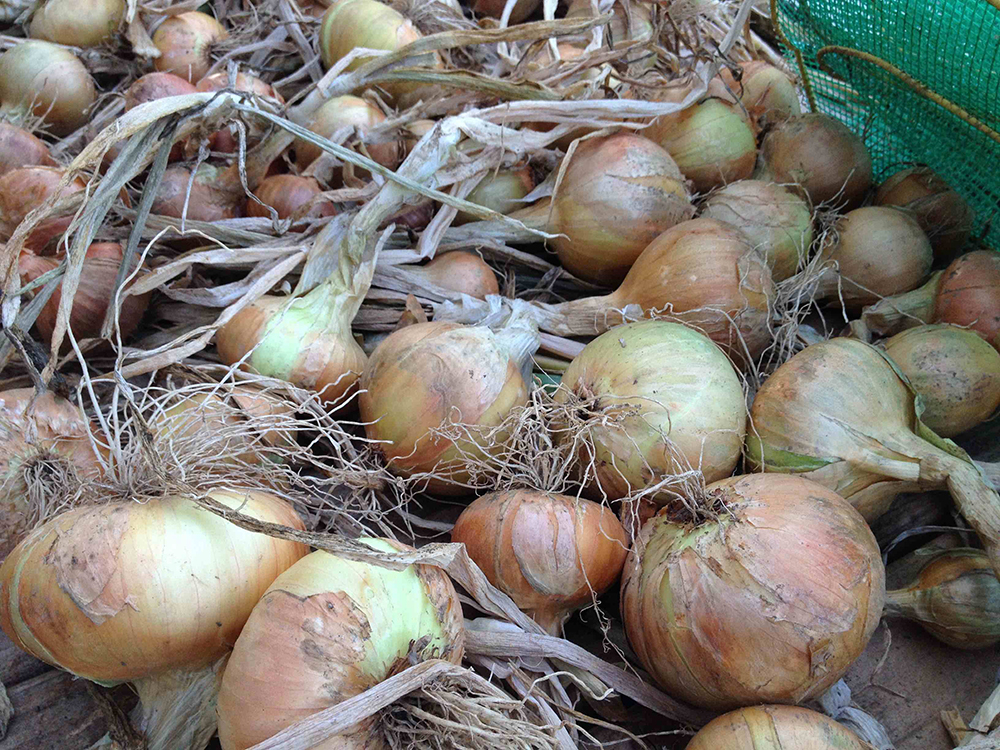Grow It Yourself - Know Your Onions
 We’ve been eating onions for the last month or so, even though they are not ready yet. The immature ‘green’ onions are a delight to eat and can be used anywhere there is a requirement for a scallion. At this stage though, the onions are moving in to a territory where they are almost ready to harvest.
We’ve been eating onions for the last month or so, even though they are not ready yet. The immature ‘green’ onions are a delight to eat and can be used anywhere there is a requirement for a scallion. At this stage though, the onions are moving in to a territory where they are almost ready to harvest.
Generally speaking onions are ready when the tops of the plants fall over. An old trick was to bend the stems yourself, but this is now frowned upon. Many GIYers then loosen the soil around the bulb with a fork to accelerate bulb ripening and allow them some more space to swell - a suggestion I once received was to turn the onion very gently and very slightly in the soil, which presumably achieves the same thing.
 A week or so after the stems have bent over, the leaves will wither and yellow. Lift the onions and shake off the soil. If the weather is dry, place them on a wire rack outside to dry. If rain is forecast, keep them on a rack in the greenhouse or tunnel. Leave for 10 days to dry out or until the skin is paper thin. It is this drying process that gets the onions ready for storing.
A week or so after the stems have bent over, the leaves will wither and yellow. Lift the onions and shake off the soil. If the weather is dry, place them on a wire rack outside to dry. If rain is forecast, keep them on a rack in the greenhouse or tunnel. Leave for 10 days to dry out or until the skin is paper thin. It is this drying process that gets the onions ready for storing.
The presence of moisture in the onions is what causes them to rot in storage so make sure all the moisture is gone from them (particularly in the neck) before you store. Store in net bags or make a braid by twisting the onion tops around some wire or garden twine. Store somewhere cool and dry. Remove any shoots that form over the winter.
The Basics – Bolting
Bolting is a term which refers to vegetable crops that run to seed before their time. The plant is essentially rushing in to procreation mode - trying to spread its seed (by producing flower or seed heads) before it dies. It is a perfectly natural part of the plant's lifecycle, but unfortunately from a GIYers perspective it usually renders them inedible. It is often caused by a cold spell, changes in day length or other stress in the plant such as lack of water. Some plants such as lettuce, rocket and annual spinach are particularly susceptible.
Though bolting occurs as the plant reaches maturity it can be caused or initiated much earlier in the life-cycle. In annual crops it is usually caused by changes in day length but can be worsened by stressed conditions (lack of water, very dry soil etc). In biannual crops it is caused by unsettled weather conditions or a cold spell early in the propagation phase. Cold nights, followed by hot days will also cause it, as will late frosts.
The three main methods of controlling bolting are (1) soil conditions, (2) paying attention to sowing times, and (3) using bolt resistant varieties. I also find that succession sowings are the best way to beat bolting and provide a constant supply of produce.
Seasonal Tip – Make your Own Herbal Tea with Lemon Verbena
Lemon verbena has the most refreshing lemon aroma, much superior in my view to the more usual lemon balm. It makes a wonderful tea herb. All you need to do is to put a few leaves in a mug, pour boiling water over it and drink it a few minutes later.
In South America it is also used medicinally to treat fevers and headaches as well as for its relaxing properties. It is an excellent crop for your polytunnel, greenhouse or conservatory, but it will also do ok outside as long as it’s in a relatively dry, free draining soil, and somewhere sunny.
Recipe of the Month – Kohlrabi Carpaccio
I reckon I’ve come across the secret to cooking with kohlrabi – don’t cook it! Raw dishes make the most of its wonderful crunchiness and flavour. This healthy lunch or supper can be put together in minutes and serves four people.
Ingredients
• 1 medium (or 2 small) kohlrabi
• 4-6 anchovy fillets cut into thin strips
• 50g hard goat's cheese
• 1 tsp fresh thyme leaves
• Juice of 1 lemon
• 2 tbsp rapeseed oil
• Salt and freshly ground black pepper
Peel the kohlrabi, slice it into thin slivers with a vegetable peeler and divide these between four plates (or one larger platter). Scatter the strips of anchovy fillet on top of the kohlrabi, then shave the goat's cheese over, again using a vegetable peeler. Sprinkle on the thyme leaves, squeeze over a spritz of lemon juice and trickle on a little rapeseed oil. Season with salt and pepper to taste, and serve at once.
Michael Kelly is an author, broadcaster and founder of GIY.





There are currently no comments
Leave a comment
Not a member? Register for your free membership now!
Or leave a comment by logging in with: